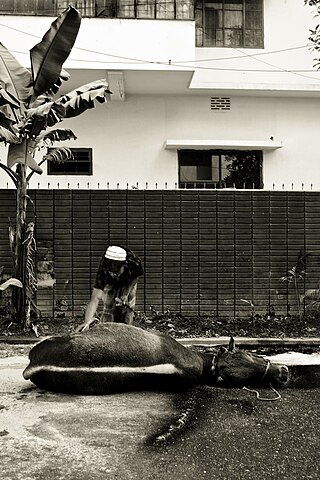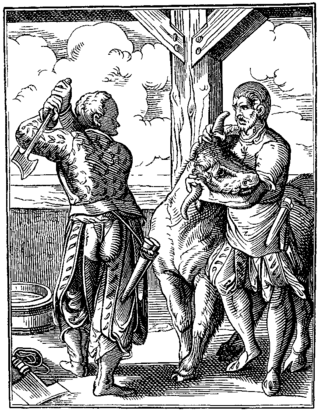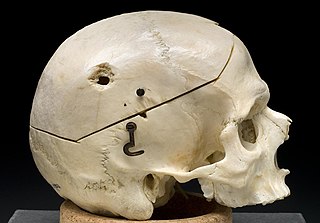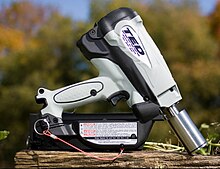
Transmissible spongiform encephalopathies (TSEs) also known as prion diseases, are a group of progressive, incurable, and fatal conditions that are associated with prions and affect the brain and nervous system of many animals, including humans, cattle, and sheep. According to the most widespread hypothesis, they are transmitted by prions, though some other data suggest an involvement of a Spiroplasma infection. Mental and physical abilities deteriorate and many tiny holes appear in the cortex causing it to appear like a sponge when brain tissue obtained at autopsy is examined under a microscope. The disorders cause impairment of brain function, including memory changes, personality changes and problems with movement that worsen chronically.
Exsanguination is death caused by loss of blood. Depending upon the health of the individual, people usually die from losing half to two-thirds of their blood; a loss of roughly one-third of the blood volume is considered very serious. Even a single deep cut can warrant suturing and hospitalization, especially if trauma, a vein or artery, or another comorbidity is involved. The word comes from the Latin 'sanguis', meaning blood.
Animal euthanasia is the act of killing an animal humanely, most commonly with injectable drugs. Reasons for euthanasia include incurable conditions or diseases, lack of resources to continue supporting the animal, or laboratory test procedures. Euthanasia methods are designed to cause minimal pain and distress. Euthanasia is distinct from animal slaughter and pest control.

A blank is a firearm cartridge that, when fired, does not shoot a projectile like a bullet or pellet, but generates a muzzle flash and an explosive sound like a normal gunshot would. Firearms may need to be modified to allow a blank to cycle the action, and the shooter experiences less recoil with a blank than with a live round. Blanks are often used in prop guns for shooting simulations that have no need for ballistic results, but still demand light and sound effects, such as in historical reenactments, special effects for theatre, movie and television productions, combat training, for signaling, and cowboy mounted shooting. Specialised blank cartridges are also used for their propellant force in fields as varied as construction, shooting sports, and fishing and general recreation.

In Judaism, shechita is ritual slaughtering of certain mammals and birds for food according to kashrut.
Stopping power is the ability of a weapon – typically a ranged weapon such as a firearm – to cause a target to be incapacitated or immobilized. Stopping power contrasts with lethality in that it pertains only to a weapon's ability to make the target cease action, regardless of whether or not death ultimately occurs. Which ammunition cartridges have the greatest stopping power is a much-debated topic.
Pithing is a technique used to immobilize or kill an animal by inserting a needle or metal rod into its brain.

Stunning is the process of rendering animals immobile or unconscious, with or without killing the animal, when or immediately prior to slaughtering them for food.

The Humane Slaughter Act, or the Humane Methods of Livestock Slaughter Act, is a United States federal law designed to decrease suffering of livestock during slaughter. It was approved on August 27, 1958. The most notable of these requirements is the need to have an animal completely sedated and insensible to pain. This is to minimize the suffering to the point where the animal feels nothing at all, instead blacking out and never waking. This differs from animal to animal as size increases and decreases. Larger animals such as bovines require a stronger method than chickens, for example. Bovines require electronarcosis or something equally potent, though electronarcosis remains a standard. The bovine would have a device placed on their head that, once activated, sends an electric charge that efficiently and safely stuns them. Chickens, on the other hand, require much less current to be efficiently sedated and are given a run under electrically charged water. To ensure that these guidelines are met, the Food Safety and Inspection Service inspectors at slaughtering plants are responsible for overseeing compliance, and have the authority to stop slaughter lines and order plant employees to take corrective actions. Although more than 168 million chickens and around 9 billion broiler chickens are killed for food in the United States yearly, the Humane Slaughter Act specifically mentions only cattle, calves, horses, mules, sheep and swine.

A contact shot is a gunshot wound incurred while the muzzle of the firearm is in direct contact with the body at the moment of discharge. Contact shots are often the result of close-range gunfights, suicide, or execution.

In Islamic law, dhabihah, also spelled zabiha, is the prescribed method of slaughter for halal animals. It consists of a swift, deep incision to the throat with a very sharp knife, cutting the wind pipe, jugular veins and carotid arteries on both sides but leaving the spinal cord intact. The butcher is also required to call upon the name of Allah (Bismillah) individually for each animal.
Horse slaughter is the practice of slaughtering horses to produce meat for consumption. Humans have long consumed horse meat; the oldest known cave art, the 30,000-year-old paintings in France's Chauvet Cave, depict horses with other wild animals hunted by humans. Equine domestication is believed to have begun to raise horses for human consumption. The practice has become controversial in some parts of the world due to several concerns: whether horses are managed humanely in industrial slaughter; whether horses not raised for consumption yield safe meat, and whether it is appropriate to consume what some view as a companion animal.

Beef cattle are cattle raised for meat production. The meat of mature or almost mature cattle is mostly known as beef. In beef production there are three main stages: cow-calf operations, backgrounding, and feedlot operations. The production cycle of the animals starts at cow-calf operations; this operation is designed specifically to breed cows for their offspring. From here the calves are backgrounded for a feedlot. Animals grown specifically for the feedlot are known as feeder cattle, the goal of these animals is fattening. Animals not grown for a feedlot are typically female and are commonly known as replacement heifers. While the principal use of beef cattle is meat production, other uses include leather, and beef by-products used in candy, shampoo, cosmetics, and insulin.

Animal slaughter is the killing of animals, usually referring to killing domestic livestock. It is estimated that each year, 80 billion land animals are slaughtered for food. Most animals are slaughtered for food; however, they may also be slaughtered for other reasons such as for harvesting of pelts, being diseased and unsuitable for consumption, or being surplus for maintaining a breeding stock. Slaughter typically involves some initial cutting, opening the major body cavities to remove the entrails and offal but usually leaving the carcass in one piece. Such dressing can be done by hunters in the field or in a slaughterhouse. Later, the carcass is usually butchered into smaller cuts.
Bolt gun or boltgun may refer to:

A gunshot wound (GSW) is a penetrating injury caused by a projectile from a gun. Damages may include bleeding, bone fractures, organ damage, wound infection, loss of the ability to move part of the body, and in severe cases, death. Damage depends on the part of the body hit, the path the bullet follows through the body, and the type and speed of the bullet. Long-term complications can include bowel obstruction, failure to thrive, neurogenic bladder and paralysis, recurrent cardiorespiratory distress and pneumothorax, hypoxic brain injury leading to early dementia, amputations, chronic pain and pain with light touch (hyperalgesia), deep venous thrombosis with pulmonary embolus, limb swelling and debility, and lead poisoning.
The following are terms related to firearms and ammunition topics.

Bovine spongiform encephalopathy (BSE), commonly known as mad cow disease, is an incurable and invariably fatal neurodegenerative disease of cattle. Symptoms include abnormal behavior, trouble walking, and weight loss. Later in the course of the disease, the cow becomes unable to function normally. There is conflicting information about the time between infection and onset of symptoms. In 2002, the World Health Organization (WHO) suggested it to be approximately four to five years. Time from onset of symptoms to death is generally weeks to months. Spread to humans is believed to result in variant Creutzfeldt–Jakob disease (vCJD). As of 2018, a total of 231 cases of vCJD had been reported globally.
Fish slaughter is the process of killing fish, typically after harvesting at sea or from fish farms. At least one trillion fish are killed each year for commercial consumption. Some fish harvesting uses controversial methods like suffocation in air, carbon-dioxide stunning, or ice chilling that have been called inhumane by many organizations such as the World Organisation for Animal Health. However, due to many culture's reliance on fish, some alternative methods of slaughter have been developed. Some methods include percussive stunning, pithing, shooting, and electrical stunning. These methods face criticism, but are equally as effective. Despite this, these method still face criticism along with some arguing that no such method may ever be humane.

The Humane Slaughter Association (HSA) supports research, training, and development to improve the welfare of livestock during transport and slaughter. It provides technical information about handling and slaughter on its website, training for farmer staff and vets, advice to governments and industry, and funding of science and technology to make slaughter more humane. HSA is the sister charity to Universities Federation for Animal Welfare.














